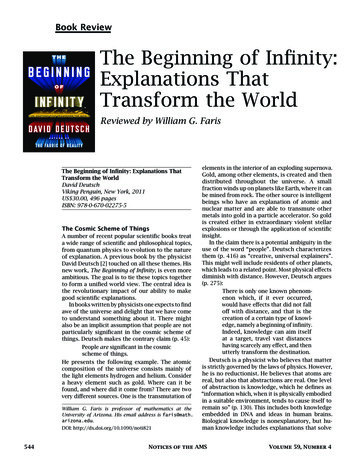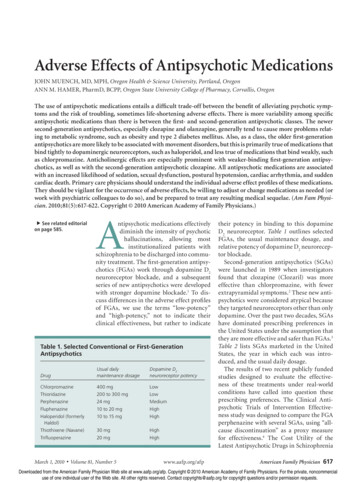
Transcription
Book ReviewThe Beginning of Infinity:Explanations ThatTransform the WorldReviewed by William G. FarisThe Beginning of Infinity: Explanations ThatTransform the WorldDavid DeutschViking Penguin, New York, 2011US 30.00, 496 pagesISBN: 978-0-670-02275-5The Cosmic Scheme of ThingsA number of recent popular scientific books treata wide range of scientific and philosophical topics,from quantum physics to evolution to the natureof explanation. A previous book by the physicistDavid Deutsch [2] touched on all these themes. Hisnew work, The Beginning of Infinity, is even moreambitious. The goal is to tie these topics togetherto form a unified world view. The central idea isthe revolutionary impact of our ability to makegood scientific explanations.In books written by physicists one expects to findawe of the universe and delight that we have cometo understand something about it. There mightalso be an implicit assumption that people are notparticularly significant in the cosmic scheme ofthings. Deutsch makes the contrary claim (p. 45):People are significant in the cosmicscheme of things.He presents the following example. The atomiccomposition of the universe consists mainly ofthe light elements hydrogen and helium. Considera heavy element such as gold. Where can it befound, and where did it come from? There are twovery different sources. One is the transmutation ofWilliam G. Faris is professor of mathematics at theUniversity of Arizona. His email address is faris@math.arizona.edu.DOI: http://dx.doi.org/10.1090/noti821544elements in the interior of an exploding supernova.Gold, among other elements, is created and thendistributed throughout the universe. A smallfraction winds up on planets like Earth, where it canbe mined from rock. The other source is intelligentbeings who have an explanation of atomic andnuclear matter and are able to transmute othermetals into gold in a particle accelerator. So goldis created either in extraordinary violent stellarexplosions or through the application of scientificinsight.In the claim there is a potential ambiguity in theuse of the word “people”. Deutsch characterizesthem (p. 416) as “creative, universal explainers”.This might well include residents of other planets,which leads to a related point. Most physical effectsdiminish with distance. However, Deutsch argues(p. 275):There is only one known phenomenon which, if it ever occurred,would have effects that did not falloff with distance, and that is thecreation of a certain type of knowledge, namely a beginning of infinity.Indeed, knowledge can aim itselfat a target, travel vast distanceshaving scarcely any effect, and thenutterly transform the destination.Deutsch is a physicist who believes that matteris strictly governed by the laws of physics. However,he is no reductionist. He believes that atoms arereal, but also that abstractions are real. One levelof abstraction is knowledge, which he defines as“information which, when it is physically embodiedin a suitable environment, tends to cause itself toremain so” (p. 130). This includes both knowledgeembedded in DNA and ideas in human brains.Biological knowledge is nonexplanatory, but human knowledge includes explanations that solveNotices of the AMSVolume 59, Number 4
Good ExplanationsDeutsch attributes recent progress to the discovery of how to create good explanations. A “goodexplanation” is defined as an explanation “thatis hard to vary while still accounting for what itpurports to account for” (p. 30). This philosophyis inspired by the writings of Karl Popper. In hisinfluential works, Popper argued against empiricism, the notion that we derive all our knowledgefrom sensory experience. There is no such thingas raw experience; scientific observation is alwaystheory-laden. Furthermore, there is no principleof inductive reasoning that says that patterns ofthe past will be repeated in the future. In Popper’sview the path to scientific progress is to makeconjectures and then test them. Deutsch insiststhat even explanations that are testable are notenough; they should be good explanations in thesense that he defines.His version of philosophy of science has twocomplementary strands. One is realism, the notionthat there is a physical world about which itis possible to obtain knowledge. The other isfallibilism, the doctrine that there is no sure pathto justify the knowledge that has been obtained atany stage. These together support the metaphorof a knowledge base of good explanations that isincreasing but bounded above by a reality that isnever fully knowable.One useful feature of the book is the explicitdefinitions of philosophical terms, explaining howApril 2012they are used in his system. Thus “instrumentalism”is defined as the “misconception that science cannotdescribe reality, only predictoutcomes of observations”(p. 31). As is clear from thisexample, definitions oftencome with a judgment.Deutsch’s main work as aphysicist has been on quantum computing, and it isnatural that he would testKarl Popper:his ideas in the frameworkphilosopher ofof quantum theory. Thisleads to a problem. Quan- “theory-laden”science.tum theory is the acceptedframework for understanding properties of matter, viewed as consisting ofconstituents on the molecular, atomic, and subatomic scale. It explains such properties of matteras density and strength and conductivity and color.It also underlies the deeper understanding of thechemical bond. It is so pervasive in fundamentalphysics that it is difficult to see how to make thesmallest modification to it without destroying thewhole edifice.The problem is that the formulation of quantumtheory is abstract and mathematical, and, as usuallypresented, it also has a peculiar dual character.There is a law of time evolution given by theSchrödinger equation: For every time interval thereis a transformation U obtained by solving thisequation. It maps the initial state of a system to thefinal state of a system. (The notation U indicates aunitary linear transformation.)There is another law of time evolution, a randomtransformation R that determines the result ofthe measurement. Various possibilities for thistransformation may occur, according to certaincalculated probabilities. The state change underthis transformation is called reduction or collapse.The origin of the transformation R is thatit describes an intervention from the outside.The system is in a certain state. A physicistsets up a measuring apparatus and performs theexperiment. The observed outcome occurs. Thenew state after the experiment is determined by theparticular R that corresponds to the experimentaloutcome. If the experiment is repeated underidentical conditions, then the outcomes vary, butthe frequencies are predicted by the calculatedprobabilities.Such instrumentalist accounts have a long andcomplicated history. An early version is sometimesreferred to as the “Copenhagen interpretation”,since it stems from ideas of Niels Bohr and hisschool. (See [8] for a critical account.) DeutschNotices of the AMSReproduced with the permission of theLibrary of the London School of Economics.unexpected problems. The gold example showsthat an explanation can have physical effects justas real as those created by an exploding star.Deutsch’s book is also a manifesto in praise ofthe notion of progress. His claim is that a newkind of progress began with the Enlightenment.In the best case the growth of knowledge mayproceed indefinitely in the future without bound.This is the “beginning of infinity” of the titleand of the quotation above. The argument hasseveral threads. It begins with a definite positionon philosophy of science, centered on an argumentthat a notion of “good explanation” of reality isthe key to progress. It includes a theory of culturalevolution, which explains obstacles to progressand the lucky circumstance that swept them away.There is extensive discussion of the anomalousstatus of quantum theory, which on some accountsis incompatible with a realistic world view. Theargument connects views on topics as varied asmathematical reality, voting systems, aesthetics,and sustainability. The author rejects sustainabilityas an aspiration or as a constraint on planning;he favors an open-ended journey of creation andexploration.545
will have none of this. For him instrumentalismis defeat; the only acceptable account is realistic.Here is his explicit definition (or dismissal) ofBohr’s approach (p. 324):Copenhagen interpretationNiels Bohr’s combination of instrumentalism, anthropocentrism andstudied ambiguity, used to avoidunderstanding quantum theory asbeing about reality.If the instrumentalist account is not acceptable,then what are the alternatives? One is to developa theory that includes the deterministic U timeevolution but also has additional structure. Thisstructure should introduce randomness in someway; perhaps the reduction transformation R willemerge as a consequence. The other way is todevelop a theory with only the deterministic timeevolution U . Such a theory must explain why theoutcomes of experiments on quantum systemsappear random.The final section of this review gives a moredetailed discussion of these alternatives. It willcome as no surprise that Deutsch prefers a realisticversion of quantum theory with only the dynamicaltime evolution given by U. This seems the happiestoutcome, but we shall see the price he must pay.Copyright of Max Alexander, STARMUS.Cultural Evolution546Many of the ideas in this book are related toevolutionary theory. In biologicalevolution genes are replicated,and they change through variationand selection. In cultural evolutionthe analog of a gene is a “meme”.(The term was coined by RichardDawkins in 1976.) Memes arereplicated, and they also changethrough variation and selection.The copying mechanism is different for genes and memes. Agene exists in a physical formas DNA that may be copied intact through several generationswithout ever being expressed asbehavior. It acts much like a computer program. A meme can beRichard Dawkins: copied only if it is enacted. In fact,evolutionary a meme has two forms. It may betheorist. an idea in a brain. This idea mayprovoke a behavioral embodimentof the meme, such as action or body language orspeech. The idea in the next recipient brain hasto be guessed from the observed behavior. Thesuccessful meme variant is the one that changesthe behavior of its holders in such a way as tomake itself best at displacing other memes fromthe population.Deutsch contrasts two ways that a meme maysuccessfully replicate itself. A meme may surviveas a meme of conformity, because it is never questioned. It relies on disabling the recipients’ criticalfacilities. When such memes dominate, the result isa static society in which dangerous dysfunctionalmemes are suppressed. The other possibility isa dynamic society. In such a society memes arereplicated in a rapidly changing environment. Thiscan take place in a culture of criticism, becausethe memes embody new truths.The transition from a static society to a dynamicsociety depends on an almost accidental shift inhow meme transmission is employed. A memecannot be simply copied from behavior. There hasto be a mental capacity to infer the idea from thebehavior. This creative ability developed in serviceto the task of replicating memes of conformity. Itwas hijacked to the task of creating new knowledge.Deutsch considers the transition to a societywhere there is deliberate creation of new knowledgeto begin with the Enlightenment. There is no precisedate, but the founding of the Royal Society in 1660is a landmark. There may have been previoustransitions that did not survive. Deutsch calls sucha period a “mini-enlightenment”. He speculates thattwo such mini-enlightenments may have occurred.One was at the time of the Athenian advances inpolitical freedom and openness to new ideas inphilosophy and science. Another was when Florencebecame a center of creativity in art, accompanied byadvances in science, philosophy, and technology. Inboth cases the initial spark was extinguished. Thishas major enduring consequences (pp. 220–221):The inhabitants of Florence in 1494or Athens in 404 BCE could be forgiven for concluding that optimismjust isn’t factually true. For theyknow nothing of such things asthe reach of explanations or thepower of science or even laws ofnature as we understand them, letalone the moral and technologicalprogress that was to follow whenthe Enlightenment got under way.At the moment of defeat, it musthave seemed at least plausible tothe formerly optimistic Atheniansthat the Spartans might be right,and to the formerly optimistic Florentines that Savonarola might be.Like every other destruction ofoptimism, whether in a whole civilization or in a single individual,these must have been unspeakablecatastrophes for those who haddared to expect progress. But weshould feel more than sympathyNotices of the AMSVolume 59, Number 4
Quantum Theoryfor these people. We should takeit personally. For if any of thoseearlier experiments in optimismhad succeeded, our species wouldbe exploring the stars by now, andyou and I would be immortal.As we have seen, Deutsch’s book combinesvarious threads to create a vision of continuingprogress in enlightenment and human flourishing.It is a unified portrait that explains scientificadvance and puts it in a moral framework. Thevision is supported by a great number of assertions,some of them extravagant. Take, for instance, hisclaim that “everything that is not forbidden by lawsof nature is achievable, given the right knowledge”(p. 76). Here is a supporting argument (p. 56):. . .every putative physical transformation, to be performed in a giventime with given resources or underany other conditions, is either:— impossible because it is forbidden by laws of nature;or— achievable, given the rightknowledge.That momentous dichotomy existsbecause if there were transformations that technology could neverachieve regardless of what knowledge was brought to bear, thenthis fact would itself be a testableregularity in nature. But all regularities in nature have explanations, sothe explanation of that regularitywould itself be a law of nature, or aconsequence of one. And so, again,everything that is not forbidden bylaws of nature is achievable, giventhe right knowledge.(1)A passage like this is tough to decipher.The question of whether to believe every detailmay be beside the point. A manifesto is not ascientific or philosophical treatise; it is an outlineof a world view that one can try on for comfort.Some readers will find satisfaction in a systematicview of the world that is compatible with notionsof science and progress. Others may find it toosimple or too optimistic. In the latter case they areviolating yet another of Deutsch’s maxims (p. 212):The Principle of OptimismAll evils are caused by insufficient knowledge.So much the worse for them.April 2012From here on this review concentrates on quantumtheory and is more technical. The formulationof quantum theory centers on the wave function,a quantity that is difficult to interpret in termsof a realistic world view. In compensation thetheory has an elegant mathematical structure.What follows is a brief review of this structure,followed by a discussion of three possibilitiesfor interpretation. (Deutsch would not agree thatinterpretation is an issue, since he sees only onereasonable way to think of the theory.)The state of a quantum system at a givenmoment in time is described by a complex valuedwave function ψ(x). This depends on the positionsof all the particles in the system. For instance, saythat there are N particles (no spin or statistics). Theposition of particle i at fixed time is described by acoordinate xi in three-dimensional space. The wavefunction depends on x (x1 , . . . , xN ), which rangesover configuration space of dimension 3N. This isalready an incredible picture of nature: everythingis related to everything else through the wavefunction. In particular, the joint probability densityfor the system of N particles is proportional toρ(x) ψ(x) 2 .It is possible for the different particles to be highlycorrelated, even when they are widely separated inspace.The change in the state over a given timeinterval is ordinarily given by a transformationU . This transformation is deterministic, and it iscomputed by solving the Schrödinger equation.This is a complicated linear partial differentialequation, and much of theoretical physics consistsof attempts to solve it for some particular system.1Since the Schrödinger equation is linear, thecorresponding transformations U are also linear.This naturally leads to a more abstract point ofview. The characteristic feature of vectors is that itis possible to take linear combinations of vectorsto produce new vectors. In particular, if ψ1 andψ2 are vectors, then the sum ψ1 ψ2 is also avector. Also, every scalar multiple of a vector is avector. Since wave functions share these properties,there is a convention of calling a wave function avector. This in turn leads to the use of geometrical1In some accounts the complete description of the physical state of a quantum system involves more than its wavefunction; it brings in additional structure, namely the actualpositions of the particles. This leads to the question of howto specify the time evolution of particle positions. This issueis not treated in orthodox quantum mechanics, but Bohmianmechanics and Féynes-Nelson stochastic mechanics eachspecify a possible continuous time evolution for particle positions. The reviewer thanks Sheldon Goldstein for commentson this topic.Notices of the AMS547
ψ1 ψ2 ψψ2 (x)BBψ1 (x) BψBBBMBψ21 B ψ1 B B B Bkψ1k2 kψ2k2 kψk2 1 BBBBBBBFigure 1. Example of orthogonal functions.Figure 2. Probability Pythagoras.analogies. (The fact that the scalars are complexnumbers is only a minor problem.)Each pair of vectors ψ1 and ψ2 has a scalarproduct hψ1 , ψ2 i. This too has an analog for wavefunctions; the scalar product is defined by thedefinite integralZ(2)hψ1 , ψ2 i ψ1 (x)ψ2 (x) dx.If kψk2 1, then the theorem of Pythagorashas the special formX(6)1 kψj k2 .The space of all wave functions is regarded asa vector space of functions, in fact, as a Hilbertspace. Each vector ψ in the Hilbert space has anorm (length) kψk which is determined by theusual formula kψk2 hψ, ψi for the square of thenorm. In the case of wave functions the explicitexpression isZ(3)kψk2 ψ(x) 2 dx.Vectors ψ1 and ψ2 are orthogonal (perpendicular) if their scalar product has the value zero, thatis, hψ1 , ψ2 i 0. (Figure 1 shows an example oforthogonal wave functions. In this example ψ1 (x)is even and ψ2 (x) is odd, so their product hasintegral zero.) With these definitions various notions of geometry have attractive generalizations.Suppose, for instance, that there is a sequence oforthogonal vectors ψj with sum ψ, soX(4)ψ ψj .jIn this situation the theorem of Pythagoras takesthe formX(5)kψk2 kψj k2 .j548jThese give positive numbers that sum to one,just what is needed for probability. In fact, thisis the standard framework for the interpretationof quantum mechanics. For simplicity consideran observable quantity with discrete values, suchas the energy of a bound system. The possiblevalues are indexed by j. The observable quantitydetermines a decomposition of the Hilbert spaceinto orthogonal subspaces.2 The state vector is avector ψ of unit length. It is expressed as a sum(4) of the projected vectors. Different observablequantities define different decompositions. Foreach observable quantity there are probabilitiesgiven by the terms in (6).This geometrical picture of quantum mechanics,abstract and beautiful, is immensely appealing.The reviewer is tempted to summarize it in aslogan:Probability PythagorasTo see such a surprising and satisfying connection(Figure 2) is to be seduced by perfection. However,as we shall see, there are reasons to resist its allure.2The mathematical structureis an orthogonal direct sumLdecomposition H j Hj of the Hilbert space. There arecorresponding real numbers λj that are possible values forthe observable quantity. These data determine a self-adjointoperator A whose action on each Hj is multiplication by λj .If ψ is the state vector and ψj is the orthogonal projectionof ψ onto Hj , then the expected value of this quantity hasPthe elegant expression j λj kψj k2 hψ, Aψi.Notices of the AMSVolume 59, Number 4
The trouble begins with a counterexample.Consider a quantum system. Each possible decomposition (4) defines probabilities. It is tempting tothink of these probabilities as describing outcomesassociated with this system. This is not a consistentview. An early argument to this effect was givenby John Bell. A more recent example of LucianHardy [5] makes the same point in an even moreconvincing way. Something else is needed to selecta particular decomposition relevant to a givensituation. See the appendix for a brief account ofHardy’s argument.What is it that determines which decompositionis relevant? If in a given situation probabilities areto predict frequencies, then which probabilitiesare to be used, and which are to be discarded?Any serious account of quantum mechanics mustconsider this problem. There are various ways toaddress it, but in the reviewer’s view they fall intothree general classes: Instrumentalism Quantum theory with additional structure Pure quantum theoryThe instrumentalist account of quantum theory emphasizes its ability to make experimentalpredictions. This solves the problem, because theoutcomes emerge as a result of the particular experimental setup. Deutsch summarizes the usualrule for such predictions (p. 307):With hindsight, we can state therule of thumb like this: whenevera measurement is made, all thehistories but one cease to exist.The surviving one is chosen atrandom, with the probability ofeach possible outcome being equalto the total measure of all thehistories in which that outcomeoccurs.He then describes the adoption of the instrumentalist interpretation (p. 307):At that point, disaster struck. Instead of trying to improve andintegrate these two powerful butslightly flawed explanatory theories [of Schrödinger and Heisenberg], and to explain why therule of thumb worked, most ofthe theoretical-physics communityretreated rapidly and with remarkable docility into instrumentalism.If the predictions work, they reasoned, then why worry about theexplanation? So they tried to regardquantum theory as being nothingbut a set of rules of thumb forpredicting the observed outcomesApril 2012of experiments, saying nothing(else) about reality. This move isstill popular today, and is knownto its critics (and even to someof its proponents) as the ‘shutup-and-calculate interpretation ofquantum theory’.In an instrumentalist account the relevantdecomposition into orthogonal subspaces is determined by the measurement one performs onthe system. This leads to the nontrivial problem:how does one characterize measurement? Thereis no universally accepted solution. The notionof “measurement” is defined with varying degreesof precision. In some versions a measurementis said to necessarily involve interactions on amacroscopic scale. This is in spite of the fact thatthe macroscopic world is supposed to be made ofatoms.The mathematical formulation ignores mostof this detail. The particular measurement isspecified by an orthogonal decomposition, whichthen determines a decomposition of the statevector ψ as a sum of components ψj as in (4). Foreach j there is a reduction operator Rj . The effectof reduction on the state vector ψ is another vectorχj Rj ψ. In some accounts it is required thatχj ψj , but this is unnecessarily restrictive. Allthat is needed is that kχj k2 kψj k2 . The particularj that is used is random; its probability is givenby the squared norm kψj k2 . Strictly speaking, thevector χj is not a state vector, since it does nothave norm one. However, it may be multiplied bya scalar to give a normalized state vector, whichcould be taken as a new state of the system.In general, a probability describes the statisticsof what happens when an experiment is repeatedmany times. But what happens in a particularexperiment? As always in probability, when theexperiment is performed, a particular outcomevalue j 0 occurs. In this instrumentalist versionof quantum mechanics there is an additionalpostulate: the new reduced wave function isχj 0 Rj 0 ψ. No mechanism is given.Another direction is quantum theory with additional structure. One ingredient might be to try tomodel the experimental apparatus along with thesystem of interest. There can also be an explicitmechanism for introducing randomness. Some ofthe ideas go back to von Neumann; others havebeen elaborated by various authors. There is noagreement on details. Here is a brief account ofa possible view, taken from [4]. It is not universally accepted; in particular, Deutsch presumablywould be appalled at the ad hoc introduction ofrandomness.The complete description involves the systemof interest together with an environment, formingNotices of the AMS549
what one might call the total system. The systemof interest might be a particle, an atom, or amolecule. To make the description concrete, itwill be called an atomic system. The environmentcould be an experimental apparatus or, moregenerally, a larger system of some complexity.For brevity call it the apparatus. The combinedsystem is described by a wave function Ψ (x, y),where x describes the positions of particles in theatomic system, and y describes the positions ofparticles in the apparatus. Typically there is nonatural way for the wave function for the combinedsystem to determine a wave function for the atomicsubsystem.One situation where it is meaningful to havea wave function ψ(x) for the atomic subsystemis when the total system wave function is of theproduct form(7)Ψ0 (x, y) ψ(x)φ0 (y).Suppose that this is an initial state that has noimmediate interaction between the atomic systemand apparatus. This means that the wave functionis nonzero only if the xi are so far away from theyj that the interaction is negligible. The atomsare headed toward the apparatus, but they arenot there yet. As long as the combined wavefunction has this form, the dynamics of the atomicsubsystem is described by the Schrödinger timeevolution U for the atomic system alone.Now the system is to interact with the apparatus.The starting point is a decomposition of the wavefunction ψ(x) of the atomic system as a sumX(8)ψ(x) ψj (x).Courtesy of Mark Everett.j550The measurement itself is accomplished by theunitary dynamics of the combined system. Thisdeterministic transformation must be appropriateto the decomposition (8) in the following sense.It should map each wave function ψj (x)φ0 (y) to a new wavefunction χj (x)φj (y) for whichthe new environment wave function φj (y) factor also dependson j. These wave functionsφj (y) should be normalizedand form an orthogonal family.This implies that the atomicwave function normalization ispreserved, in the sense thatkχj k2 kψj k2 . For such atransformation to exist, theremust be a physical interacHugh Everett: originatortion of a suitable type—forof many-worldsinstance, electric or magnetic—quantum theory.between the atomic system andapparatus.yψ(x) ψ1 (x) ψ2 (x)initialfinal 2ψ(x)φ0 (y) χ1 (x)φ1 (y) χ2 (x)φ2 (y) 1 xFigure 3. Support of system-apparatus wavefunction.Suppose that there is suchan interaction. Since the transformation is linear,it maps Ψ0 to a state Ψ in which the atomic systemis coupled to the states of the apparatus. The newwave function isX(9)Ψ (x, y) χj (x)φj (y).jOne can think of χj (x) as the result of applyinga reduction operator Rj to the state ψ(x). Theprobability associated with such an atomic wavefunction is kχj k2 kψj k2 .The apparatus wave functions φj (y) arefunctions of the apparatus configurationy (y1 , y2 , . . . , yM ), where M is the numberof particles in the apparatus. When M is very largeit is plausible that the apparatus wave functionsφj (y) with various indices j are macroscopicallydifferent. Such effects have been studied under thename quantum decoherence. (See [7] for a recentsurvey.) In the present account the conditionthat the apparatus states are macroscopicallydifferent is interpreted to mean that the wavefunctions φj (y) with different j are supportedon subsets with negligible overlap in apparatusconfiguration space (Figure 3). The correspondingatomic wave functions χj (x) are the result ofdynamical interaction. Each of them is a candidatefor the result of the reduction process.In order to have an actual result, additionalstructure is required. This is obtained by introducing a new dynamics with random outcome. One ofthe indices is randomly selected. Say that this isthe j 0 index. Then the corresponding reduced wavefunction of the atomic system is the χj 0 (x) given byapplying Rj 0 to ψ(x). This reduction process doesnot contradict the unitary dynamics for the atomicsubsystem. The wave function for the atomic subsystem is not even defined while the atomic systemand apparatus are interacting; it is only definedNotices of the AMSVolume 59, Number 4
before the interaction and after the interaction isover. Suppose that for a subsequent time intervala decomposition (9) with nonoverlapping φj (y)persists and there is no immediate interactionbetween the atomic system and apparatus. Thenover this interval of time the wave function of theatomic subsystem continues to be defined, andthe deterministic dynamics U describes its timeevolution.The reader will notice that the above account iscomplicated and artificial. However, it is at leastconsistent. This is because it is a consequence of avariant of quantum theory [3] that is itself knownto be consistent.The final possibility is pure quantum theory.Almost everyone agrees on the dete
This is the "beginning of infinity" of the title and of the quotation above. The argument has several threads. It begins with a definite position on philosophy of science, centered on an argument that a notion of "good explanation" of reality is the key to progress. It includes a theory of cultural evolution, which explains obstacles .











